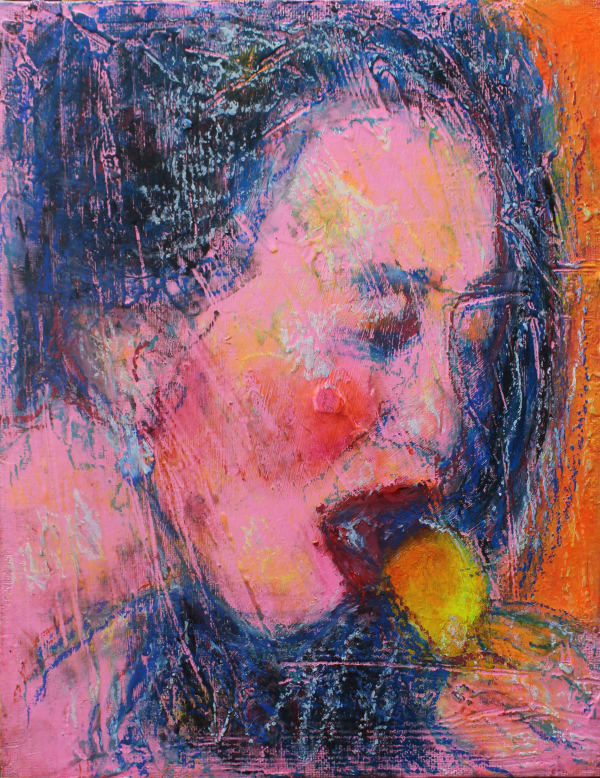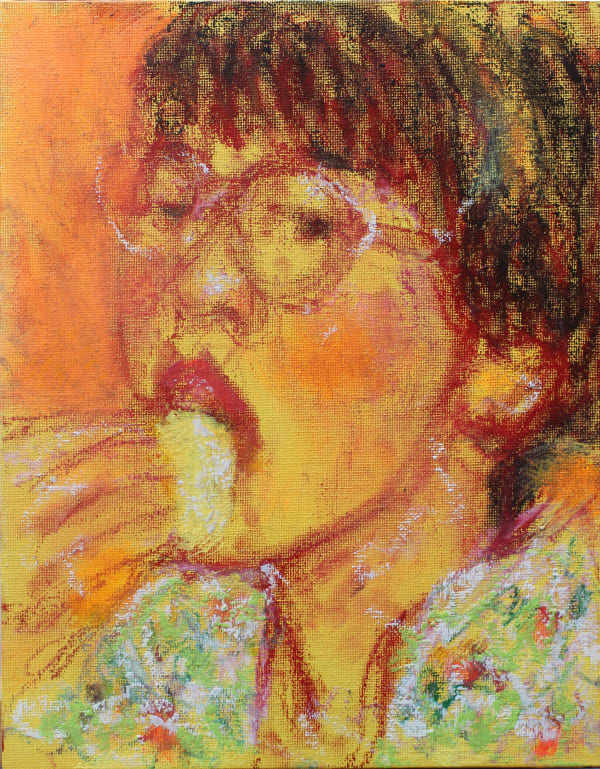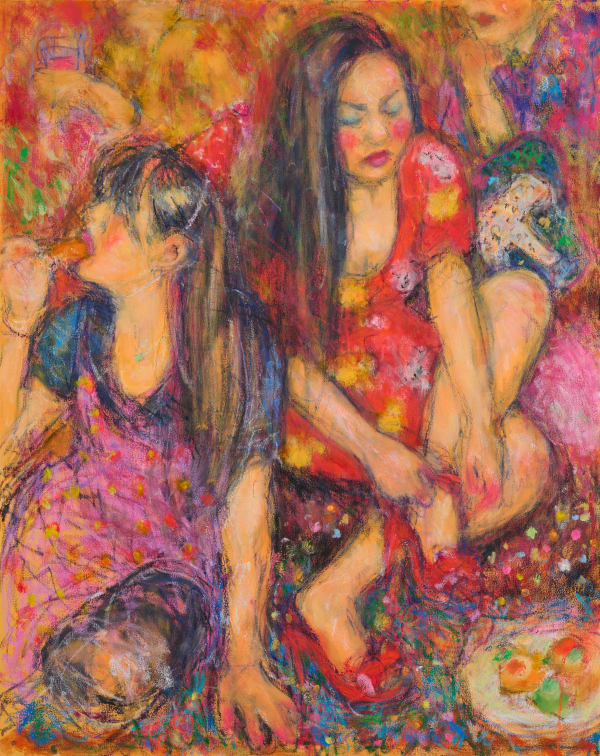Picnics and Parties: Caroline Wong
Past exhibition
Overview
Private View
Thursday 04.04 at 6–8 PM
The first time I engaged in conversation with Caroline Wong for the writing of this very text, I encountered her through my laptop screen. Her studio backdrop featured one of her large-scale paintings and it seemed as if the artist joined one of her exclusively female circles. I had been eagerly anticipating this conversation for a while, as I had studied Wong's paintings extensively. I realised that they seemed both very recognisable and simultaneously very distinctive.
The moment of recognition may be attributed to my classical education as an art historian, as my inner eye recalls the classes on French Impressionist painters such as Renoir, Pissarro or Morisot. Wong's large-scale canvases echo the style of these artists by capturing everyday transient moments with dynamic and visually striking compositions, characterised by loose, visible brushwork. As the title already indicates, Summer/Autumn luncheon (after Tissot) (2023) takes its inspiration from the painting Holiday (1876) by James Tissot, a French Impressionist who went on to live in London, the current home of Wong. However, Wong's work transcends the bourgeois realm of Impressionism by introducing what she describes as "scruffy ornamentalism" into her practice. This term reflects her desire to retain the visual opulence and allure of Asian ornamentation but present it in a messy, haphazard manner, resulting in an excess of colours, patterns, and surfaces. In her book Ornamentalism which serves as a great inspiration to Wong, American literary scholar and cultural theorist Anne Anlin Cheng explores the conflation of Ornament with the Orient, and the inevitable association of Asiatic femininity with the decorative and ornamental. This is a thorny, complex issue, but inspired by Cheng, Wong questions whether the decorative and ornamental can be imbued with new significations other than simply connoting passivity, delicacy, and objectification.
Picnics and Parties is about the escapist pleasures of consumption and intoxication. It depicts the 'artificial paradise', to quote the Decadent poet Baudelaire, of alcohol, cigarettes, food, and companionship, but also that of clashing patterns, lurid colours, and iridescent hues. The decorative becomes 'drunk', the ornamental detail dissolves into frenetic daubs, and artifice blends decadently with sensuality. Building up layers over several months, Wong works oil paint, oil pastel, and fluorescent pigments with brushes and her hands, combining hazy, fizzy scribbles with more lush, exuberant passages of paint. In our talk, she cites Intimist painter Bonnard as a key influence. He worked slowly and tactilely to 'recover the savour of things' - to relish a singular moment, extracting the magical and sensorial from the banal. Ultimately, in an age of decisiveness and efficiency, Wong opts for a protracted, indulgent process that favours an aesthetic of luxuriance and excess.
Wong's intoxicated, indecorous odalisques are monumental and imposing. Life-size or even larger, their intertwined bodies merge with their chaotic, cluttered surroundings and fill the entire canvas. It's undeniable to me that the women themselves and their interconnectedness propel them into a frenzy. I believe that their lively presence stems from the vitality of the painting's previous stages. At the outset of each piece, Wong follows in the footsteps of her predecessors by engaging models and friends to visit her studio and act out the scenes that will subsequently be depicted in her paintings. This is also why her characters - actual women as opposed to invented ideals - reflect the diverse facets of contemporary femininity in their appearances. This collaborative approach, coupled with Wong's unconventional and almost frenzied painting method, challenges the traditional canon of composition and femininity.
As I conclude my journey through Wong's canvases, I find myself newly invigorated by the substantial dose of authenticity and the effortless self-assurance that her female characters embody.
– Cathrin Mayer, 2024
– Cathrin Mayer, 2024
Caroline Wong’s work responds to traditional, restricted representations of East Asian women. For Wong, subverting these ideals is the essence of her practice. Her beginnings, as an artist, lay in more traditional forms of portraiture, yet, as she has grown, she has nurtured the epicurean side of herself, moving towards more excitable, expressive mark-making driven by a hedonistic desire for fun. She likens creating to eating. In both, she becomes consumed by the moment of pleasure, detaching herself from the world. The final image presents a hot, sticky portal of pleasure and the senses. The scintillating heat of her portraits is a visual representation of this joy and decadence, whilst also being reminiscent of the chaos and colour of Southeast Asia. Whether depicting female friendships or obdurately exhibiting female pleasure in food, her work is a joyful push-back against tradition, celebrating the beauty in excess.
Wong received her MA from City and Guilds of London Art School in 2021. Prior to that, she received her Diploma in Contemporary Portraiture from The Art Academy in 2018. Solo exhibitions include Castello di San Basilio, Pisticci, Italy, Rusha & Co., Los Angeles (2023), Soho Revue, London, Soy Capitán, Berlin (2022). She has been shown at several international fairs and was one of the selected artists in Whitechapel's auction in 2024. In Sweden, her work has been shown in the group exhibition You Were Bigger Than the Sky, You Were More Than Just a Short Time, 2023.
Photo credit: Graeme Duddridge and Caroline Wong
Installation Views
Works









